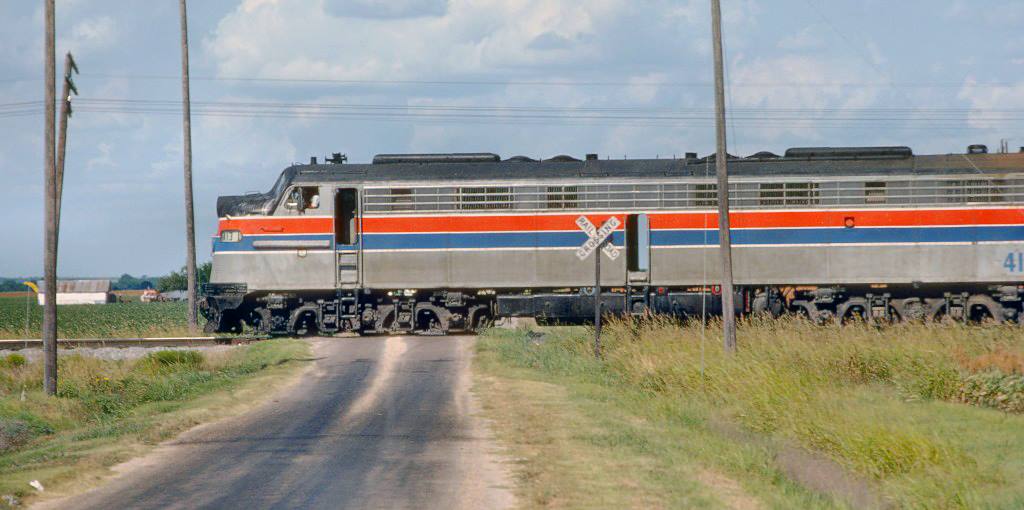- Home ›
- Amtrak ›
- Inter-American
Amtrak's "Inter-American" (Train): Consist, Timetable, History
Last revised: September 5, 2024
By: Adam Burns
The Inter-American was a passenger service operated by Amtrak between Chicago and Laredo, Texas. Its route changed a handful of times during its eight years of service it was eventually replaced by the Texas Eagle due to budget cuts.
The train was initially established in 1973, running between Fort Worth and Laredo, before at first being extended to St. Louis and then finally to Chicago. The Inter-American was renamed the Texas Eagle in 1981, and this service continues to operate, albeit on a slightly different route.
Photos
 In this scene, Amtrak E8A #413 (ex-Chicago, Burlington & Quincy #9944-B) is ahead of the "Inter-American" as the train speeds through a rural grade-crossing near Taylor, Texas during a July afternoon in 1977. This service ended in 1981. Gary Morris photo.
In this scene, Amtrak E8A #413 (ex-Chicago, Burlington & Quincy #9944-B) is ahead of the "Inter-American" as the train speeds through a rural grade-crossing near Taylor, Texas during a July afternoon in 1977. This service ended in 1981. Gary Morris photo.Inauguration
The Inter-American is a unique chapter in America's railway history, belonging to the prestigious lineage of Amtrak trains. During the carrier's early years it attempted to continuing providing service over most of the routes it had inherited.
This included the Missouri Pacific's former Texas Eagle. On January 27, 1973 Amtrak launched the Inter-American to service to connect Fort Worth with Laredo, Texas. It also offered a connection wtih the National Railroad of Mexico (Ferrocarril Nacional de México) for through service to Mexico City.
In addition, at Fort Worth one could transfer to the Texas Chief to reach Kansas City and Chicago although doing so required an overnight layover in Fort Worth.
In March, 1974 Amtrak extended the train to St. Louis; the all-reserved seats included coaches, a diner-lounger, and sleeping car (roomettes and bedrooms).
Its final extension occurred in October, 1976 when it began running through to Chicago but retained thrice-weekly service between Fort Worth-Laredo (southbound ran on Monday-Thursday-Saturday while its northbound counterpart ran on Sunday-Tuesday-Friday).
In its final incarnation the train provided major stops at Joliet, Bloomington, St. Louis, Little Rock, Texarkana, Dallas, Fort Worth, San Antonio, and Austin. The northbound train from Laredo was assigned number 21, while the southbound train to Laredo from Chicago was recognized as number 22.
Timetable (October, 1976)
| Time/Leave (Train #21) | Milepost | Location | Time/Arrive (Train #22) |
|---|---|---|---|
| 8:45 AM | 0.0 | 9:15 PM | |
| 9:18 AM | 37 | 8:07 PM | |
| 10:41 AM | 126 | 6:50 PM | |
| 11:41 AM | 185 | 5:50 PM | |
| 12:46 PM | 257 | 4:45 PM | |
| 1:55 PM (Ar) | 282 | 4:00 PM (Dp) | |
| 2:30 PM (Dp) | 282 | 3:00 PM (Ar) | |
| 6:10 PM (Ar) | 445 | 11:00 AM (Dp) | |
| 6:15 PM (Dp) | 445 | 10:55 AM (Ar) | |
| 7:15 PM | 504 | 9:50 AM | |
| 8:00 PM | 541 | 9:05 AM | |
| 9:50 PM (Ar) | 624 | 7:20 AM (Dp) | |
| 10:00 PM (Dp) | 624 | 7:10 AM (Ar) | |
| 10:50 PM | 668 | 6:15 AM (Ar) | |
| 1:05 AM (Ar) | 767 | 4:10 AM (Dp) | |
| 1:20 AM (Dp) | 767 | 3:55 AM (Ar) | |
| 2:45 AM | 833 | 2:20 AM | |
| 3:25 AM | 857 | 1:45 AM | |
| 6:30 AM | 984 | 11:00 PM | |
| 7:35 AM (Ar) | 1015 | 9:40 PM (Dp) | |
| Time/Leave (Train #21): Monday-Thursday-Saturday | Milepost | Location | Time/Arrive (Train #22): Sunday-Tuesday-Friday |
| 7:50 AM (Dp) | 1015 | 9:25 PM (Ar) | |
| 8:30 AM (Ar) | 1044 | 8:45 PM (Dp) | |
| 8:31 AM (Dp) | 1044 | 8:35 PM (Ar) | |
| 9:36 AM | 1118 | 7:18 PM | |
| 10:10 AM (Ar) | 1143 | 6:50 PM (Dp) | |
| 10:20 AM (Dp) | 1143 | 6:42 PM (Ar) | |
| 11:20 AM | 1181 | 5:45 PM | |
| 12:05 PM | 1216 | 4:50 PM | |
| 12:50 PM | 1247 | 4:05 PM | |
| 1:55 PM (Ar) | 1296 | 2:55 PM (Dp) | |
| 2:05 PM (Dp) | 1296 | 2:45 PM (Ar) | |
| 6:15 PM | 1449 | 10:55 AM |
The sheer expanse of the Inter-American is an intriguing study. Spanning approximately 1,449 miles (2,332 kilometers) in its journey from Chicago to Laredo, it transported passengers through a myriad of landscapes and regional terrains.
The Inter-American carried a notable, albeit somber, footnote in history as being the final train to serve St. Louis Union Station when the northbound run to Chicago left the terminal on October 31, 1978.
Following the facility's closure as a station Amtrak shifted its St. Louis services to a temporary "Amshack" two blocks east. Today, all trains serve the Gateway Transportation Center, one block east of Union Station.
Final Years
By the late 1970s Amtrak was forced to greatly reduce its operational footprint due to budget constraints. The Inter-American's first notable changes occurred in October, 1979 when it was combined with the Lone Star, a service which linked Chicago-Houston (ex-Texas Chief).
The Inter-American name was retained and ran as a section to Houston with the train split at Temple, Texas. The final change occurred on October 1, 1981 when the train was truncated at San Antonio and discontinued the section to Houston altogether.
Texas Eagle
In addition, the train was renamed as the Eagle, which later transitioned into today's Texas Eagle. The primary route remained similar, with Chicago being retained as the northern terminus, while the southern end was curtailed at San Antonio.
The Texas Eagle, in itself, has become a beloved part of the Amtrak lineage and continues to serve the public effectively. It has upheld the legacy of the Inter-American, maintaining the cherished railway corridor and offering top-notch services to its passengers.
The Inter-American holds a special place in American railway history. Its promise of connecting the Midwest to the South, offering lavish services, and being a cornerstone in establishing long-distance passenger routes is commendable.
It was through this journey with the Inter-American, Lone Star, and Texas Eagle that Amtrak demonstrated its resilience and determination. These services highlight the evolving story of railway operations as influenced by social, financial, and legislative forces.
The remnants of Inter-American, though not physical, continue to guide and inspire present and future operations. The measures adopted, the challenges faced, and the solutions executed throughout its tenure provide insightful learnings for the entire sector.
The role of the Inter-American in stimulating commerce, fostering social interactions, and building a reliable transportation backbone are its indelible imprints on the societal framework of the United States.
Inter-American's commitment to progress and adaptation, as evident in its transition to the Texas Eagle, symbolizes the significant pathways that modern rail services need to tread for success.
In conclusion, the Inter-American's journey, marked by challenges, victories, rebrands, and timeless service, is a testament to human ingenuity, resourcefulness, and the constant endeavor for progress. It stands not just as a chapter in the Amtrak chronicle but as an enduring narrative of American railway heritage.
Recent Articles
-
Pennsylvania's Whiskey Train Rides
Jul 07, 25 12:28 AM
For whiskey aficionados and history buffs alike, a train ride through the Keystone State offering such spirits provides a unique and memorable experience. -
Whiskey Train Rides: A Complete Guide
Jul 07, 25 12:14 AM
These rides across the United States offer a sensory journey through lush landscapes and historical corridors, often pairing scenic vistas with curated whiskey tastings. -
Utah Wine Tasting Train Rides
Jul 06, 25 11:54 PM
Utah, a state widely celebrated for its breathtaking natural beauty and dramatic landscapes, is also gaining recognition for an unexpected yet delightful experience: wine tasting trains.


